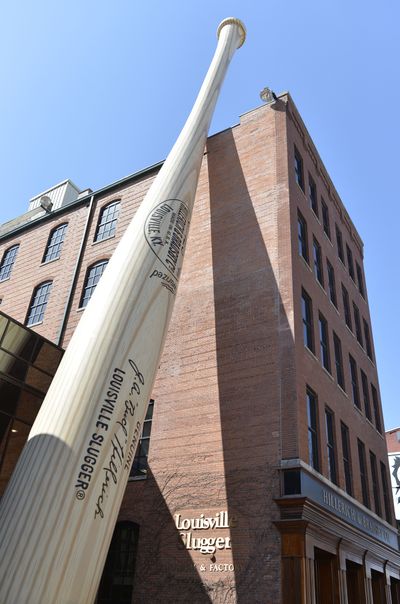Louisville Slugger bat brand sold to Wilson Sporting Goods
Family owners cite increased competition

Over a century of family ownership of Louisville Slugger bats is going … going … nearly gone.
The company that makes the iconic bats gripped by generations of ballplayers – from Babe Ruth to David Wright – announced a deal Monday to sell its Louisville Slugger brand to rival Wilson Sporting Goods Co. for $70 million.
For 131 years, the family behind Hillerich & Bradsby Co. has supplied bats for games from the sandlots to the big leagues.
H&B CEO John A. Hillerich IV said keeping the bat business in family hands had been a dinnertime topic for years. But as the competition’s lineup grew in recent years, the family became willing to listen to offers to acquire the brand.
“It’s always been the family’s desire to keep the brand independent and family owned,” Hillerich told reporters. “It’s worked extremely well for 131 years.
“But we’ve seen things change and we had to make a very tough decision. We’d rather the brand go on and have somebody else own it than potentially put it in jeopardy by keeping it in the family.”
Hillerich is the great-grandson of John A. “Bud” Hillerich, who churned out the first Louisville Slugger bat in 1884 for a renowned baseball player in his day, Pete Browning.
Under terms of the agreement, H&B will continue to manufacture Louisville Slugger wood bats at its factory in downtown Louisville, Kentucky.
“The guys down on the floor today are going to be the guys making the bats tomorrow and a year from now and a decade from now,” Hillerich said.
But sale of the brand will cost 52 H&B workers their jobs, out of a total workforce numbering about 270, Hillerich said. The remaining employees will work either for H&B or Wilson.
Louisville Slugger will remain an independent brand once the deal is completed, said Mike Dowse, president of Wilson Sporting Goods. That means the Louisville Slugger bats will still carry the brand’s recognizable oval logo.
Wilson’s deal to acquire the global brand, sales and innovation rights of Louisville Slugger still requires approval by H&B shareholders.
Wilson Sporting Goods is a division of Finnish sports equipment maker Amer Sports Corp. The Helsinki-based company said it expects the deal to be completed in the second quarter.
Former players who now manage major-league clubs sounded nostalgic about the age-old brand on Monday.
“I still remember my first Louisville Slugger bat as a kid,” Hall of Fame player and current Minnesota Twins manager Paul Molitor said. “All I knew was that Harmon Killebrew used one, and that was good enough for me. Part of the excitement of signing your first pro contract was getting a bat deal with Louisville Slugger.”
Former All-Star player Matt Williams, who now manages the Washington Nationals, said Louisville Slugger bats were popular among players of his generation.
“There’s so many bats today to choose from that I, for one, would go crazy trying to choose a bat or a company,” he said. “I was a Louisville guy. Used them for a long time.”
About half of all current major league players swing Louisville Slugger bats, according to H&B. The company said it has churned out more than 100 million bats in its history, including aluminum and composite bats.
The sale includes the brand’s aluminum and composite bats, as well as Louisville Slugger lines of fielding and batting gloves, protective gear and equipment bags.
Louisville Slugger’s wood bats are formed mostly out of northern white ash or maple, but a small percentage is made out of birch. The timber comes from forests in New York and Pennsylvania.
H&B will maintain ownership of and continue to operate the Louisville Slugger Museum & Factory and Gift Shop, a popular tourist destination. Towering outside the museum and factory is a 120-foot-tall steel bat that looms as a landmark in downtown Louisville.